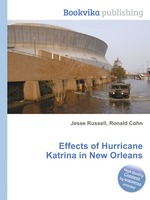Effects of Hurricane Katrina in New Orleans
Jesse Russell Ronald Cohn
бумажная книга
High Quality Content by WIKIPEDIA articles! The effects of Hurricane Katrina in New Orleans have been long-lasting. As the center of Katrina passed South-east of New Orleans on August 29, 2005, winds downtown were in the Category 3 range with frequent intense gusts and tidal surge. Hurricane force winds were experienced throughout the city, although the most severe portion of Katrina missed the city, hitting nearby St. Bernard and Plaquemines parishes. Hurricane Katrina made its final landfall in eastern St. Tammany Parish. The western eye wall passed directly over St. Tammany Parish, Louisiana as a Category 3 hurricane at about 9:45 AM CST, August 29, 2005. The communities of Slidell, Louisiana, Avery Estates, Lakeshore Estates, Oak Harbor, Eden Isles and Northshore Beach were inundated by the storm surge that extended over six miles inland. The storm surge impacted all 57 miles (92 km) of St. Tammany Parish’s coastline, including Lacombe, Mandeville and Madisonville. The storm surge in the area of the Rigolets Pass is estimated 16 feet, not including wave action, declining to 7 feet (2.1 m) at Madisonville. The surge had a second peak in eastern St. Tammany as the westerly winds from the southern eye wall pushed the surge to the east, backing up at the bottleneck of the Rigolets Pass.


